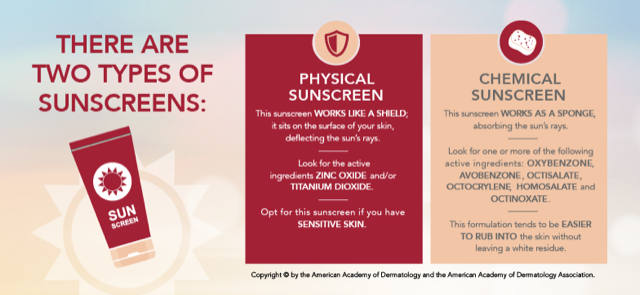PHYSICAL SUNSCREENS VS. CHEMICAL SUNSCREENS

Wearing sunscreen daily is critical to protect you from skin cancer. But should you use a physical or chemical formula. Let’s break down the differences to help you decide.
Sunscreens are categorized as chemical absorbers or physical blockers. Chemical sunscreens contain active ingredients that work by absorbing harmful UV radiation and converting it into low energy heat. These ingredients are highly effective at blocking both UVB and UVA sun rays. Chemical sunscreen formulations are the most cosmetically appealing to apply and wear. They have the least amount of “white cast,” which is the chalky white look often caused by physical sunscreens. Instead, they blend nicely with the skin when applied, but the lack of any color can make it hard to see if you have missed a spot.
One concern about chemical sunscreens is that some of ingredients have been shown to be absorbed into our bloodstreams when used regularly. Common ingredients include ensulizole, octisalate, homosalate, octocrylene, octinoxate, oxybenzone and avobenzone. If you are concerned about this, risk, a physical sunscreen is a good option.
Physical sunscreens are a bit like wearing a rain coat. They make sure that harmful UV radiation never reaches your skin. The active ingredients are minerals – zinc oxide and titanium dioxide. They are generally reduced into nano-particles so, unlike zinc sun blocks of the past, they are more transparent, rub in easier, and blend in well with the skin. Many physical sunscreens come in a “tinted” formula, which work well with most skin colors and add an elegant look that camouflages the white appearance.
Take away: Both chemical and physical sunscreens protect you against harmful UV radiation. Physical sunscreens do this by creating a barrier between you and the sun while chemical sunscreens are absorbed and protect the skin at that point in the process.
